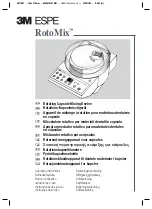
62
Marchesan Implementos e Máquinas Agrícolas “TATU” S.A.
GCRO 7010 / 7012
Adjustments and operations
2) Drawbar angle
The holes (B) on the upper and
lower plates can set a smaller or
greater cutting depth, and also can
displace the equipment laterally.
U n d e r n o r m a l w o r k i n g
conditions, the drawbar must remain
centralized as much as possible
related to the wheelsets.
• We recommend to control the depth through the disc gang opening and using
the tires only where the disk harrow penetrates excessively.
• Use the rod stops (A) to determine a smaller depth of cut, always keeping the
same depth adjustment on the disc blades.
NOTE
Tractor position related to the previous pass - Lateral displacement
The lateral displacement
is used to better position the
tractor related to the furrow
opened on the previous pass,
avoiding leaving a trace and
giving reference to the operator.
T h i s p o s i t i o n i n g i s
obtained due to the tractor
gauge and disk harrow cutting
width.
Whenever possible, the
tractor must pass over the
unworked soil and near the
previous furrow.
The displacement is done
by changing the drawbar on the
hitch bar.
Position #1: Normal position (centralized) - used on most situations.
Position #2: Allows the tractor to get closer to the previous furrow.
01
01
02
02
B
B
•
To start the harrowing, we recommend using an average opening on
the disc gangs. If a greater penetration is needed, increase the opening
angle of the rear gang.
•
The rear gang usually works with a greater opening than the front one.
•
The harrowed soil is always on the left hand side of the operator.
•
Try to make good finishing between passes. Avoid the formation of
windrows or untilled strips.
IMPORTANT
















































